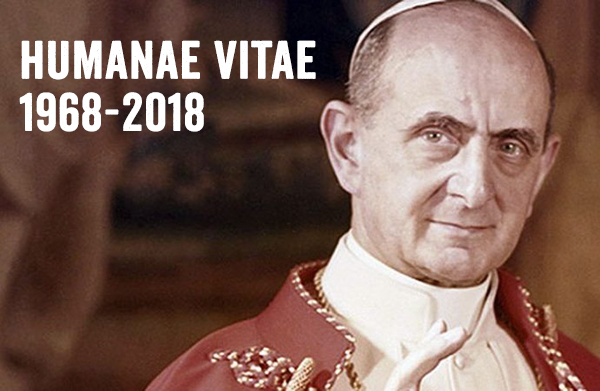By E. Christian Brugger The Catholic Thing, 28, 2018
Note: There are indications coming from Rome that there may be a reconsideration this year of “Humanae Vitae” and its prohibition of contraception. Since this would have enormous consequences for marriage and family – and the Church itself – we are publishing a very careful re-reading of this crucial encyclical by one of America’s most prominent moral theologians. Part I appears today; Part II will appear next Saturday. – Robert Royal
To “peruse” a text means to examine it carefully. To “reperuse” it means to return to it in order to examine it even more carefully, perhaps in light of new information relevant to its understanding. This type of re-examination, called in Latin a relectio, was common in 16th-century Catholic theology. The Americas were then just opening to Europeans and new questions were arising about legitimate authority, human rights, just war, slavery, and killing, especially in regard to the newly subjugated Native Americans. Theologians such as the Spaniard Francisco de Vitoria (c. 1483-1546) returned to classical texts on such matters, chiefly from Thomas Aquinas, to reflect upon the new things that were happening in the New World. His texts were called relectiones (reperusals or rereadings) and exercised enormous influence over the theological debates of the day.
In this 50thanniversary year of the publication of Pope Paul VI’s greatest text, Humanae Vitae (HV), there has been considerable talk of “rereading” the papal document in the “light” of the “new paradigm” drawn from chapter 8 of Amoris Laetitia. Unfortunately, this HV relectio, unlike its 16thcentury counterparts, has little to do with serious Christian theology. For theology takes as its non-negotiable starting points and measuring sticks the teachings of Divine Revelation as found in Scripture and Church teaching.
Therefore, a theological relectio of Humanae Vitae would reread its foundational premises, formulating them anew if necessary, while maintaining logical consistency with the contents of prior formulations, and then apply them as needed to new situations and states of affairs. The current rereading of Humanae Vitae, however, does not do this. Rather, while claiming for itself the traditional term “rereading”, it departs from the text’s foundational premises and rejects its concrete conclusions.
My purpose here is not to critique that rereading. I have done this elsewhere. Rather it is to offer my own relectio of Humanae Vitae. After briefly situating the text historically, I will re-examine its contents focusing on its foundational premises, trying to formulate them even more clearly for the present time, and then see how they can be applied to present states of affairs.
Looking Back, we can see that people have been trying to render their sex sterile for as long as they have been having sex. Whether using Coitus Interruptus (withdrawal); or crude vaginal suppositories such as were made of crocodile dung and fermented dough by the ancient Egyptians (1850 B.C.), or elephant feces as used in Arabic medicine (AD 9thc.); or natural anti-fertility agents (cedar resin, lead, galbanum, etc.) smeared on the mouth of the uterus as prescribed by the ancient gynecologist Soranus (AD 2ndc.); or the moistened copper ore prescribed by the Greek physician Hippocrates (4thc. BC).
All Christians from apostolic times rejected all forms of contraception as an attack on God’s procreative purposes for human sexuality. This stance came to an end, at least officially, at the 1930 Anglican Lambeth Conference, where the Anglican bishops, spurning, albeit reluctantly, the ancient consensus, taught for the first time that the use of contraceptive devices by married couples could be morally legitimate:
Where there is a clearly felt moral obligation to limit or avoid parenthood, the method must be decided on Christian principles. The primary and obvious method is complete abstinence from intercourse (as far as may be necessary) in a life of discipline and self-control lived in the power of the Holy Spirit. Nevertheless in those cases where there is such a clearly felt moral obligation to limit or avoid parenthood, and where there is a morally sound reason for avoiding complete abstinence, the Conference agrees that other methods may be used, provided that this is done in the light of the same Christian principles. The Conference records its strong condemnation for the use of any methods of conception control from motives of selfishness, luxury, or mere convenience. [emphasis added]
The 1958 Lambeth Conference taught with much less reticence: “[The] means [which Christian couples use in their responsible] family planning are in large measure matters of clinical and aesthetic choice . . . and Christians have every right to use the gifts of science for proper ends.”
As went Lambeth and the Anglican Communion, so went the rest of Protestant Christianity.
Humanae Vitae was not published until 1968, but the question of the morality of contraception was on the minds of the Council fathers at Vatican II. In April 1963 Pope John XXIII created a small commission of six members, which he called the Pontifical Commission on Population, Family, and Birth-rate. Its purpose was limited: to assist the Holy See to prepare for an international conference sponsored by the U.N. and World Health Organization.
Pope John died in June 1963. Critics who wanted a change in teaching urged Pope Paul VI to expand the Commission and broaden its mandate to include a wholesale reassessment of the morality of contraception. Paul was confident of the truth of the received teaching. But he had doubts about the immorality of the relatively new birth control pill. It could be taken before sexual intercourse leaving the act free from the interference of a physical prophylactic device. Was it truly contraceptive?
In early 1964, Paul considerably expanded the birth control commission in order to give the widest possible attention to the unique question of the morality of “the pill.” But he did not communicate his intentions clearly. The commission’s Secretary General, Rev. Henri de Riedmatten, O.P., a critic of the received teaching, decided to focus the commission’s attention not on questions about “the pill” but on whether the received teaching was “reformable” or “irreformable.”
A majority of the commission’s theological section (12 of 19) believed the teaching was reformable – i.e., it could be changed. Their views were summarized in a confidential report intended to be seen only by the pope. The minority members who defended the traditional teaching also wrote a report. In 1967, someone associated with the majority leaked both to the press, raising public expectations that the pope would follow the recommendations of the majority.
In an elegantly written and admirably concise text of just under 8000 words, however, the pope reaffirmed the traditional judgment that freely chosen contraceptive acts are always wrongful. His reformulation of this ancient moral norm is found in HV14. But he first provided a helpful contextualization of the social problems under consideration, and a coherent, although brief, philosophical account of marriage and sex that stands as a kind of premise for the concrete norm. Paragraph 14 is followed by insightful pastoral commentary and a series of direct addresses to different constituencies both inside and outside the Church.
His opening remarks note that recent changes in society have raised “new questions” that the Church must address: population growth, the role of women in society, the value attributed to marriage and sex, and the “stupendous progress” in mastery over nature. One of those questions is this: should the Church change its teaching on the morality of contraceptive acts, especially in light of the fact that living in accord with that teaching today can be very hard and sometimes requires “heroic sacrifices”?
The rest of the encyclical is the pope’s reply to this question.
Any ethical discussion of sex in Catholic tradition must always take place in the context of a wider consideration of the good of marriage. Since sex acts are only morally justified – indeed, only rendered fully intelligible – by marriage, we can only understand clearly which of those acts protect and support marriage or harm and weaken it by first knowing what marriage is.
For this reason, the pope provides an account of the nature of marriage. First, he says marriage is a relationship of love, taking its origin from God, who is love. This tells us little specifically about marriage since all true friendships involve love. But he goes on to say that this kind of love is sui generis (wholly unique), referring to it, following Vatican II, by the term “conjugal love.”
The verb coniungo in Latin, from which the term “conjugal” derives, means to bind together, to join, to unite. The conjugal love that is proper to marriage binds the spouses together, joins them, unites them in a wholly unique way. It is not just a union of souls, as in other platonic friendships; nor just a union of bodies, as with those who engage, say, in the hook-up culture. It is a union of both body and soul. For this reason, the pope refers to conjugal love as “fully human.” In addition, he says, married love is “total,” a love where spouses “share everything” related to the goods of body and soul. Further, it is “faithful”, that is, exclusive to the spouses until death. And finally, it is “fruitful”; conjugal love goes beyond the spouses to welcome the new life that its realization endeavors to bring into existence.
These four components of conjugal love – fullness, totality, faithfulness, and fruitfulness – make up the pope’s (and the Catholic Church’s) normative definition of marriage: an exclusive communion of persons characterized by a one-flesh and comprehensive sharing of body and soul.
From this definition, drawn from a New Testament understanding of marriage, Pope Paul draws the conclusion regarding the “inseparable connection” between the two “meanings” (significationes) “inherent” to the marriage act. The same act that intimately unites husband and wife into a one-flesh unity also “makes them apt for the generation of new life” (cf. CIC, canon 1061 §1). So unity and procreation are “inherent” to the marriage act.
To be continued.
© 2018 The Catholic Thing. All rights reserved. For reprint rights, write to: info@frinstitute.orgThe Catholic Thing is a forum for intelligent Catholic commentary. Opinions expressed by writers are solely their own.
E. Christian Brugger The Catholic Thing
Dr. E. Christian Brugger is a senior research fellow at the Culture of Life Foundation in Washington, D.C. In 2016 he was a theological consultant to the U.S. Conference of Catholic Bishops’ Committee on Doctrine. He has served as dean of the School of Philosophy and Theology at the University of Notre Dame, Australia, and the J. Francis Cardinal Stafford Professor of Moral Theology at St. John Vianney Theological Seminary in Denver. He is the author of <a href=”https://amzn.to/2vOi2hK”The Indissolubility of Marriage and the Council of Trent







